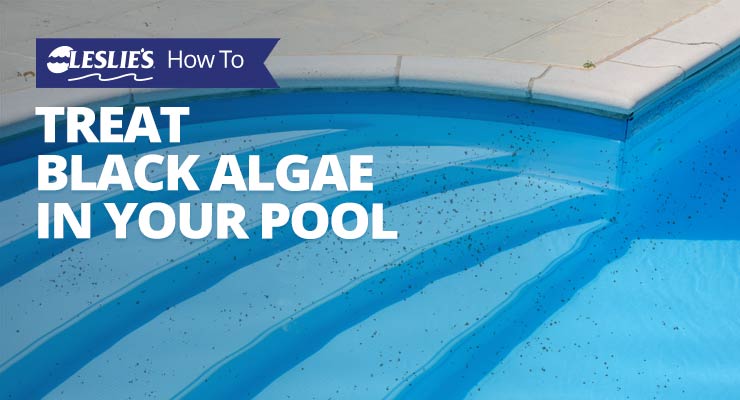
How to Treat Black Algae in Your Pool
You walk outside, ready for a swim, and see something dark on the bottom of your pool. Is it dirt? Is it just the shadows? No, it's much worse. There's black algae in your pool.
Now what? Unfortunately, ridding your pool of black algae is no easy feat. But before we discuss how to get rid of black algae, it's important to understand what it is and where it comes from. So buckle up, and let's get to it.
What is Black Algae?

Black algae is persistent and hard to kill, and it appears as pinhead to quarter-sized black spots on pool surfaces. However, there is more to black algae than meets the eye. First of all, it's technically not an algae — it's a bacteria. Second, it's not actually black, but rather a deep blue-green color. This is apparent from black algae's scientific name, cyanobacteria, with "cyan" meaning blue, and "bacteria" meaning...well, you get the picture. Certain pigments within the algae create its trademark black color when combined with water. And third, the visible portion you see is the least of your worries — it's the roots that are the real problem.
Unlike green and yellow algae, which can be easily treated with chlorine and algaecide, black algae will not go down without a serious fight. This formidable foe thrives in an environment where it can attach to porous surfaces. You likely won't have to deal with black algae if you have a fiberglass or vinyl-lined pool. However, pebble, plaster, and gunite pools provide the perfect texture for black algae to latch onto and root deeply into the pores of your pool surfaces. In addition, black algae has a protective slimy outer layer, which makes it difficult for sanitizers to penetrate. And unless you're able to kill the root, you'll have recurring black algae problems. You'll most often find it in areas of poor circulation or in deep corners of the pool.
Black algae isn't just ugly to look at. It can be problematic for your health, too. Because cyanobacteria produce cyanotoxins, it is extremely important that no one gets in the water if there is black algae in your pool. Cyanotoxins are strong natural toxins that can cause illnesses like nausea, stomach cramps, and in extreme cases, liver damage. Severity increases with the ingestion of contaminated water.
Where Does Black Algae Come From?
The real question is, how does black algae get in your pool in the first place? While green or yellow algae can easily enter your pool through wind, rain, or other natural elements, black algae generally comes from natural bodies of water.
Don't let a fun weekend trip to the lake ruin your swimming pool! After visiting any natural body of water, wash your bathing suits and thoroughly clean off any pool toys or floats that went with you. Everything should be thoroughly cleaned and sanitized before going back into your pool. Black algae can easily attach to your clothing and pool toys and travel home with you.
Treating Black Algae
Like we mentioned above, clearing black algae out of your pool is not a simple process. Due to its protective outer layer and deep roots, it's hard for chemicals to penetrate and wipe out the bacteria. But don't get discouraged — it's possible to kill the black algae and clear your pool. It just requires a lot of good ol' elbow grease and patience. So assemble your tools and supplies, and let's begin!
Needed Supplies
It's best to gather your essentials beforehand and have them ready to go. To get rid of black algae in your pool, you'll need the following products:
- Pool Water Test Kit
- Water Balancing Chemicals
- METALfree
- Leslie's Chlor Brite
- Leslie's Black Algae Killer
- Pool Brush
- Vacuum Head
- Telescoping Pool Pole
- CuLator Power Pak
- Filter Cleaner
- Phosphate Remover
- Leslie's Algae Control
1. Test and Balance Pool Water Chemistry
Get your pool water chemistry in order before tackling the black algae. Total Alkalinity (TA) and pH are the highest priority to test and balance at this stage. The TA level should be between 80–120 ppm (depending on sanitizer type), and pH should be between 7.2–7.4.
Additionally, test your pool water's copper content. If the copper level is above 0.6 ppm, staining may occur when you add Leslie's Black Algae Killer later in the process. Use METALfree, Leslie's NoMetal, or a CuLator Power Pak to lower the copper content below 0.6 ppm.
BONUS TIP: Not sure if you've got copper in your pool? Bring a pool water sample to your local Leslie's for a free AccuBlue 10-point water analysis. While you're here, we can help answer any questions you might have about treating black algae in your pool. Bring a photo, too. Sometimes splotchy metal stains can be mistaken for black algae. Either way, we can help you fix it!
2. Run the Pump, and Shock the Pool
At least 24 hours before adding Leslie's Black Algae Killer to your pool, run the pump and bring out the big guns — chlorine pool shock. Superchlorinate the pool by adding 3 pounds of Leslie's Chlor Brite per 25,000 gallons, and broadcast it directly into the deep end of the pool. Superchlorination is the only way to weaken tough black algae. Remember to shock at night for best results, and keep swimmers out of the water while chlorine levels are high.
3. Brush the Pool
We hope you stretched before this step! Grab your brush and telescopic pole, and vigorously brush every inch of your pool. Thoroughly brushing the black algae clusters will strip the cyanobacteria of its protective outer layer, making it easier for the chemicals to penetrate and kill. For gunite, plaster, or concrete pools, use a stainless steel or wire bristle brush. If you have a vinyl-lined, pebble or quartz pool, use a softer nylon brush.
4. Add Black Algae Killer
With a name like Black Algae Killer, you know you're using the right stuff. Pour Leslie's Black Algae Killer into the water around the edge of your pool at a rate of 12 ounces per 10,000 gallons. While it might be tempting to do so, don't pour the product directly over one area of algae. It needs to be spread and circulated throughout your pool to be effective.
5. Brush and Vacuum Pool
Brush any remaining black algae spots daily until they are completely gone from your pool. Continue brushing daily for at least one week after the spots disappear. Vacuum your pool to remove any settled black algae debris that may still be hanging around.
BONUS TIP: If you have the ability to vacuum to waste, it's a great way to keep much of the black algae debris out of your pool filter.
6. Use a CuLator Power Pak
24 hours after using Leslie's Black Algae Killer, add a CuLator Power Pak to your pool. This will eliminate any metals from your pool water, and will keep the copper content in check.
7. Clean Pool Filter
If there was black algae in your pool, there is definitely black algae in your pool filter. Thoroughly clean your cartridge filter, or backwash your sand or D.E. filter and use a filter cleaner to clear out any remaining black algae debris.
8. Test and Balance Water Chemistry
Finally, retest and balance your pool water chemistry before letting anyone back into the pool. Ensure pH and Total Alkalinity are within the ideal ranges, and the chlorine content is between 2.0-4.0 ppm. For best results, bring a pool water sample to your local Leslie's after the algae is all gone. With our free in-store AccuBlue water test, you'll get a precise 10-point analysis of your water chemistry, in addition to a detailed, easy-to-follow treatment plan to help resolve water balance issues and prevent black algae from returning to your pool.
Preventing Black Algae

Preventing the growth of black algae in your pool is key to ensuring you never have to go through that exhausting treatment process again.
Since black algae mainly comes from natural bodies of water, the best way to keep the pesky bacteria out of your pool is to wash swimsuits and toys after a visit to the lake or ocean. And we mean really wash them. Toss your clothes, bathing suits, and towels in the washing machine, and scrub pool toys or floats with a bleach and water solution.
Maintaining proper pool water chemistry and using Leslie's Perfect Weekly and Algae Control on a weekly basis will keep black algae growth, and many other pool problems, at bay.
Handling a black algae outbreak in your pool can be an overwhelming task. But with the right supplies and knowledge — and a bit of elbow grease — you can get your pool back to its clean, blue hue in no time. Stop by your local Leslie's if you have any questions or wish to speak to one of our friendly pool experts.